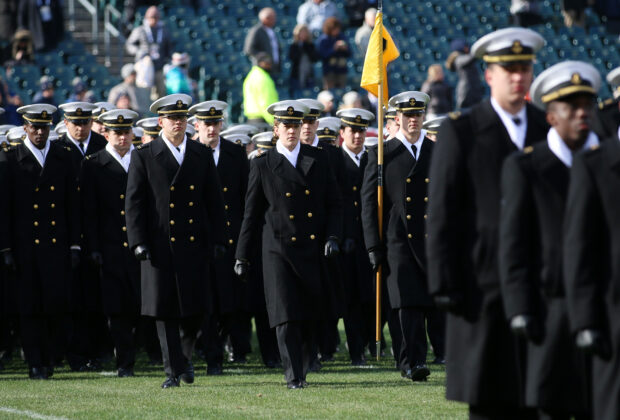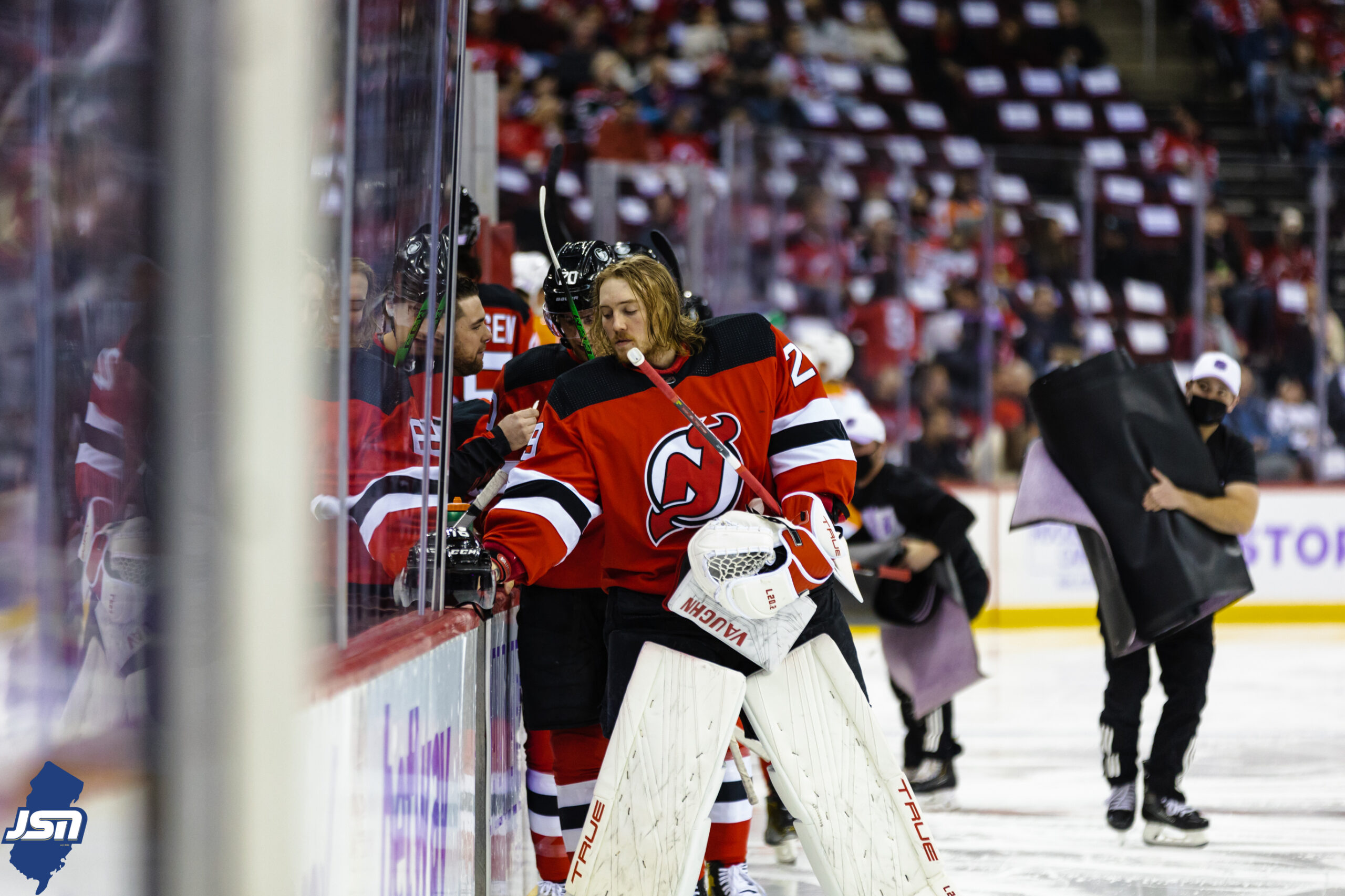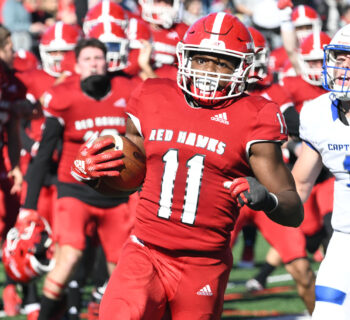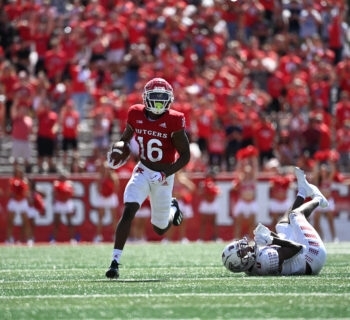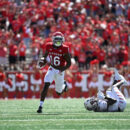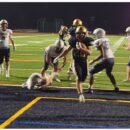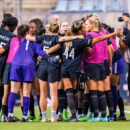“Sing Second.” It refers to how, at the end of a game, the victorious team in a contest between two of the military academies—Army, Navy, and Air Force—sings their alma mater second, after the losing team has sung theirs. With the Cadets and Midshipmen invading MetLife Stadium this weekend for the 122nd Army-Navy Game, it’s a phrase that will most likely be seen, and heard, a lot around the Meadowlands.
THE POMP & TRADITION
The Army-Navy Game has a plethora of traditions, and pomp, including, not one, but two flyovers, and parachute demonstrations. However, the highlights include traditions such as the singing of both academies’ alma maters, a precision march on, a “prisoner exchange,” and, on occasion, a presidential visit.
Pregame brings what is perhaps the most visually spectacular of Army-Navy game day traditions, the march on. During the march on the Corp of Cadets and Brigade of Midshipmen, in their entirety, march onto the field with a military precision that would be expected from future soldiers and sailors.
Additionally, pregame traditions include the “prisoner exchange.” Every year a group Second Class, or Junior, cadets and midshipmen, with high academic rankings, study at the other’s academy. During the prisoner exchange these cadets and midshipmen meet at midfield and are returned to their home academies for the duration of the game so that they can cheer for their home academies in “friendly” seating sections before returning to their exchange academies to finish out the semester.
Another tradition that is not observed as regularly as other Army-Navy traditions are presidential visits. Ten sitting presidents have attended America’s Game with the most resent being Donald Trump in 2020 and the first being Theodore Roosevelt in 1901. It is not known at the time of this writing if President Biden will be attending this year’s contest. While presidential visits are not a yearly occurrence, when it comes to these special visits, it is tradition that the president switch sides of the field at halftime so that he does not appear to show favor with one team.
Last, imagine if Ohio State and Michigan got together and participated in singing the other’s alma mater after a game. While that is probably not going to happen in this lifetime, when it comes to the Army-Navy rivalry (and any contest between the academies for that matter) that is exactly what happens. Beyond being the inspiration for the phrase “sing second,” the singing of the alma maters is a show of sportsmanship and a way to remind everyone that while, the academies may be foes “on the field of friendly strife,” to borrow from Gen. Douglas MacArthur, they are on the same team for the remainder of the year.
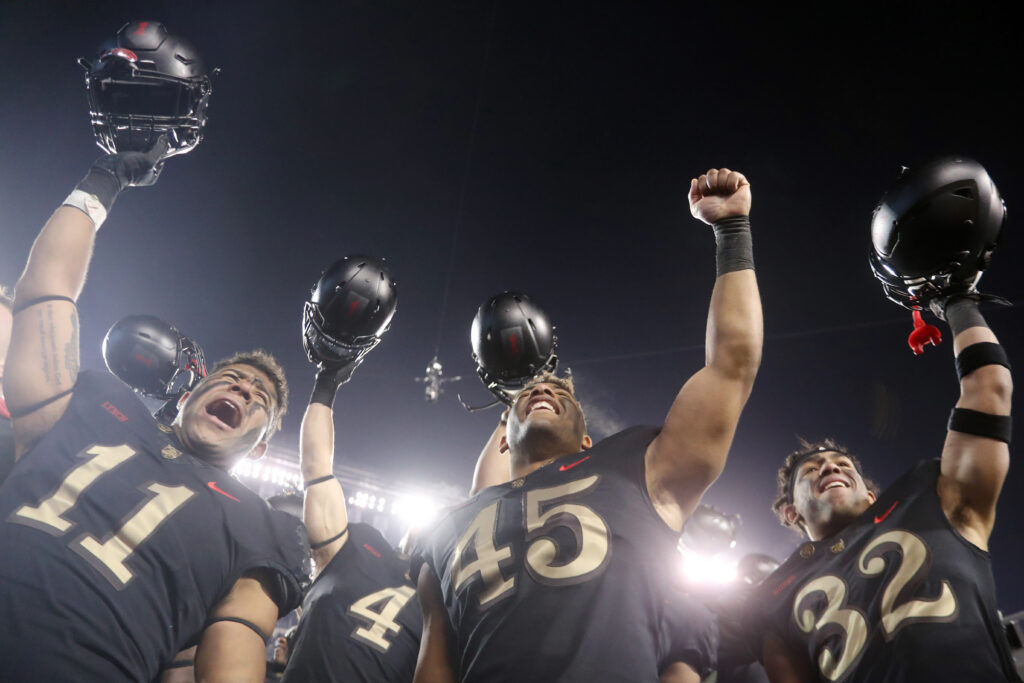
Army West Point players finish singing the West Point Alma Mater after the 2018 Army-Navy Game. (Photo: Christopher Shannon)
THE HISTORY
The first game of the Army-Navy series was played on November 29, 1890 on The Plain at West Point. That game was brought about through the efforts of Dennis Mahan Michie (for whom West Point’s Michie Stadium is named). While the Naval academy had had a team since 1879, the United States Military Academy (USMA) Academic Board was reluctant to field a team. However, Michie was able to get Navy to issue a challenge, convince his father, a professor at the academy at the time, the commandant, and Superintendent John M. Wilson that West Point’s pride was at stake. The group was then able to convince the Academic Board to allow the game on the condition that the game was held at West Point.
Michie served as captain, coach, trainer, and business manager of the initial West Point football team. He was able to scrape up volunteers throughout the Corps to play the Midshipmen, but only three had experience playing football. The inexperience of the cadets, and their lack of practice time (the cadets were only able to practice on Saturday afternoons when bad weather cancelled drills, or parades) showed in the initial game with Navy defeating Army 24-0.
The 24-0 defeat to the Naval Academy did not sit well with Michie and Superintendent Wilson. Michie found Harry Williams, a coach in Newburgh, N.Y., and the officer-in-charge of football convinced Williams to visit West Point twice a week to coach the team. Superintendent Wilson, meanwhile, approved a trip to Annapolis, Md. for a rematch. These efforts paid dividends in 1891 when a much improved Army team defeated the Midshipmen 32-16.
Since those two contests, the Army-Navy rivalry has continued relatively uninterrupted including playing during World War II, after the assassination of John F. Kennedy, and, last year, during the Coronavirus pandemic. There have, however, been ten times when the academies did not hold their annual gridiron contest.
The Army-Navy Game saw its first interruption from 1894-1898 after an argument between an Army general and Navy admiral after the 1893 game almost led to a dual. The second interruption came in 1909 when West Point cancelled its remaining games after a cadet died due to an injury sustained during a game earlier that year. The Army-Navy contest was next cancelled in 1917 and 1918 during World War I. The games during World War II, however, were not cancelled with the 1944 and 1945 games even seeing Army and Navy ranked No. 1 and No. 2. The final times that the Army-Navy Game was cancelled occurred in 1928 and 1929 when the two academies could not reconcile eligibility differences.
Beyond the 1893 game almost leading to a dual, it was also notable for another, more life preserving, innovation. While it is still debated who invented the first football helmet, Navy’s Joseph Mason Reeves is credited by multiple sources as being the first football player to wear a helmet in a game. Due to injuries, and doctors warning of possible permanent damage, the midshipman enlisted the help of an Annapolis shoemaker to make a helmet for him allowing him to continue his football career.
Philadelphia has hosted the Army-Navy game the most having been the site for 89 of the series’ games, while the New York City Metro Area is second, having hosted the Army-Navy Game 15 times (2021 will be the fifth time that the Meadowlands, specifically, has hosted the Army-Navy clash). Notably, the Army-Navy Game has been only been hosted outside the eastern United States twice. The 1926 game was hosted in Chicago as part of the formal dedication of Soldier Field, and the 1983 installment, held at the Rose Bowl, has the distinction of being the only game held west of the Mississippi River. Also, of note, the Army-Navy game has only been hosted at the respective academies six times, 1890-1893, 1942 and 1943 during World War II, and 2020 due to attendance restrictions in Philadelphia as a result of the Coronavirus pandemic.
The 1963 Army-Navy contest stands out for a couple of reasons. First, the game was almost cancelled due to President Kennedy’s assassination on November 22 of that year. With tradition dictating that the military observe a national of a 30-day period of morning, the game, which was originally scheduled for November 30, was in doubt. However, the decision was ultimately made to postpone the game by a week to December 7. According to some reports it was First Lady Jacqueline Kennedy who ultimately decided whether that the game should be played.
In a 2013 article in the New York Daily News, Navy Heisman Trophy winner, and future Dallas Cowboys quarterback, Roger Staubach is quoted as saying, “Some say Jackie Kennedy wanted the game played, but definitely the Kennedy family wanted it because he did love the Army-Navy Game. He played touch football, and Robert Kennedy was at some of our games. When we played Michigan, (RFK) was out on the front lawn of our hotel playing touch football every night. There was an affinity for Navy football and especially the Army-Navy game, so I think it was real sincere they wanted the game to be in remembrance of the President."
Beyond helping a nation heal, the 1963 Army-Navy game is also noted for the introduction of a common aspect of sports television broadcasts today. To viewers of the television broadcast, what looked like two, one yard, touchdown runs scored by Army quarterback Rollie Stichweh seconds apart were instead the first use of instant replay.
Finally, the Army-Navy Game has also been referenced on popular television. In a 1973 episode of M*A*S*H* the 53rd Army-Navy Game is referenced. In the episode a radio announcer states that the fictional game ended with Navy winning 42-36. In reality, Navy did win the actual 53rd Army-Navy Game, which took place in 1952, but the score was 7-0 in favor of the Midshipmen. To this day, no Army-Navy Game has ended with 42-36 score.
THIS YEAR’S ARMY-NAVY MATCHUP
This year’s rendition of America’s Game will take place this Saturday in the Meadowlands and will feature two, run heavy, triple option teams.
The Black Knights come into the contest sporting an 8-3 record and having received an invitation to the Armed Forces Bowl to play Missouri. While known as a run heavy team, and rightfully so, when they do throw the ball, the Black Knights make it count as they are second in the nation is passing efficiency and average 21.9 yards per completion and ten touchdowns.
Army will be looking win the Commander-In-Chiefs Trophy (the trophy given annually to the winner of the Army, Navy, and Air Force series) outright after already having retained it by holding off Air Force 21-14 in overtime earlier in the season.
Navy comes into this season’s game with a 3-8 record. While their 3-8 record may not look impressive on the surface, Navy’s strength of schedule explains some of it. The Midshipmen have faced three ranked opponents this season in No. 2 Cincinnati, No.8 Notre Dame, and No. 24 SMU.
For Navy, this year’s game is about pride and bragging rights. Additionally, the Midshipmen can still win the Secretary’s Trophy which is given to the winner of the Army-Navy Game and a victory over the Black Knight’s would go a long way towards making a rough season brighter.
In the end the Army-Navy Game is about more than just football. It’s about unique traditions, a storied past, pride, and most importantly the players on the field. For the players in Saturday’s game there will most likely be no hearing their names called during the NFL draft, instead they have chosen to answer a higher calling and serve their country and commission as second lieutenants, or ensigns, in the Army, or Navy, respectively, upon graduation. And, that is what truly makes the Army-Navy Game more than a football game.
Additional Sources:
https://www.army.mil/article/179134/the_army_navy_game_13_historical_facts_you_probably_dont_know
https://www.cbssports.com/college-football/news/staubach-leads-navy-over-army-in-1963-game-pushed-back-after-assassination-of-jfk/
https://www.usatoday.com/story/sports/ncaaf/2018/12/06/army-navy-game-gave-birth-instant-replay-55-years-ago/2212138002/
- Yul Moldauer: The Hype Man of 2024 Team USA Gymnastics - April 17, 2024
- Rutgers gymnastics scores successful St. Patrick's Day Weekend - March 18, 2024
- Jefferson's 3-point shooting dooms Bloomfield in CACC men's basketball title game - March 11, 2024

